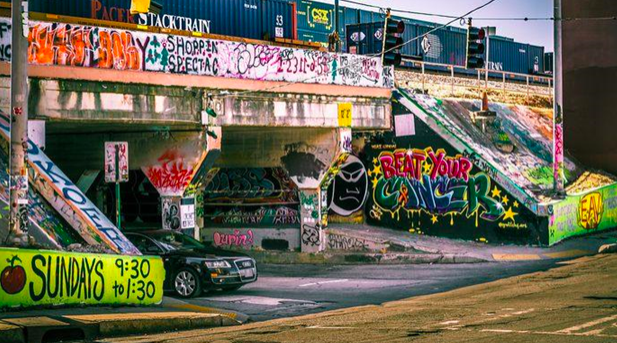Graffiti Parks Around the World
Graffiti parks are places where artists can express themselves through painting on walls, buildings, or other surfaces. They are often colorful, creative, and sometimes political. Take a look below at what other Color Parks are doing, what their rules are, and how they manage the art that is made there.
– Venice Public Art Walls at The Venice Boardwalk in California
– The Grand River Creative Corridor in Detroit, Michigan
– The Krog Street Tunnel in Atlanta, Georgia
– Wynwood Walls in Miami, Florida
– Hosier Lane in Melbourne, Australia
– Bogotá Graffiti District in Bogotá, Colombia, South America
All Graffiti Parks are governed by park rules and community agreements. Some are managed by an organization, while others are self-managed. The rules govern when it is appropriate to refresh or repaint the park, or how they deal with painting over other artists’ work. Pittsburgh’s Color Park is no different. See what our rules are.
Here in Pittsburgh and around the world, graffiti parks pose challenges and opportunities for the stakeholders involved in their management and maintenance. Our Color Park has become a beloved destination and valued community asset – but it has also been the locus of disagreement about how to manage the space, and the art there sometimes violates rules and community standards. Friends of the Riverfront is committed to keeping Color Park as a space for artistic expression, but we do remove work that violates our rules, especially when that work qualifies as hate speech.

Venice Public Art Walls - Venice, California, USA
The Venice Public Art Walls are located at the Venice Boardwalk in California. The Walls are a legal graffiti park that was established in 2007 by the STP Foundation, a nonprofit organization that promotes art and culture. The park consists of surfaces that have been approved to paint by the STP and anyone can paint on them after registering for a permit with the STP Foundation.
The STP Foundation provides materials, maintenance, security, and promotion for the park. The foundation also organizes events and workshops to educate and engage the community about graffiti art. The foundation decides when to refresh or repaint the park. The foundation respects artistic freedom but it will remove any graffiti that violates the rules.
Those rules include:
- Painting only during designated weekend hours with a permit. Permits are issued in advance or on the spot, on a first-come, first-served basis.
- Artist sketches of work must be shown and approved before painting.
- No use of spray paint by any artist under the age of 18.
- No painting anything hateful, profane, violent, obscene, or drug-related.
- No selling or advertising anything on the walls.
- Artists are required to clean up after painting and dispose of trash properly.
- No painting on trees.
How the park addresses repainting or refreshing art:
“Artists agree that any artwork on the walls is temporary in nature and that it may be removed by other artists, STP or the City of Los Angeles, at any time without notice.”

The Grand River Creative Corridor - Detroit, Michigan, USA
The Grand River Creative Corridor in Detroit, Michigan is a legal graffiti park launched in 2012 by 4731 Gallery, a local art gallery that supports urban art and culture. The park is an art space and neighborhood revitalization project that has over 100 creations that cover fifteen buildings along a two-block stretch of Grand River Avenue. In addition, the project features an outdoor fine art gallery at a bus stop; free-standing art installations; clean-ups of overgrown vegetation, trash, and vandalism; and is an economic stimulus project for local businesses.
4731 Gallery provides materials, maintenance, security, and promotion for the park. The gallery also invites local and international artists to create graffiti on the buildings, as well as organizes events and workshops to educate and engage the community about urban art and culture. The gallery decides when to refresh or repaint the park based on the availability and interest of the artists. The gallery respects the artistic vision of the artists and does not censor or remove any graffiti unless it violates the rules:
- Painting only with permission from 4731 Gallery.
- All work is created with the permission of the property owners.
- Using high-quality materials and techniques that showcase professional skills and standards.
- Not painting anything vulgar, obscene, or illegal.
Addressing repainting or refreshing art in the corridor:
““All walls rotate in the project. We are currently accepting proposals.”

The Krog Street Tunnel- Atlanta, Georgia, USA
The Krog Street Tunnel is located in Atlanta, Georgia. It is a semi-legal graffiti hub that was originally created by CSX in 1912 as an underpass connecting railroad yards, housing, businesses and factories such as the Fulton Bag and Cotton Mill. When major factories like the Fulton Cotton Mill were decommissioned in the 70’s and 80’s there was a massive economic decline in the area. In the early 2000s, neighborhood officials pledged to allow graffiti in the tunnel after a general acceptance of this form of creative expression. This acceptance could be attributed to the value placed on art and aesthetics by new residents, or because older residents were tired of painting over the graffiti. The “ordinance” was a general agreement to allow 24/7 access to Krog for artists, as long as they are respectful to the residents. Neither the Atlanta Police Department nor CSX, which still owns the tunnel, had approved this rule. As such, its legality is ambiguous.
The tunnel is self-managed by the artists who paint there. They are responsible for providing their own materials, cleaning up after themselves, and maintaining the quality and diversity of the graffiti. The tunnel is filled with graffiti that changes frequently and reflects the culture and politics of the city.
The tunnel has rules that include:
The tunnel is a free speech space where anyone is allowed to paint in the tunnel, 24/7, as long as the artists are respectful to residents.
Addressing repainting or refreshing art in the tunnel:
“They said if you come back in a few weeks, you’ll find something totally different on the walls. How cool to have an ever–changing canvas.”

Wynwood Walls- Miami, Florida, USA
Wynwood Walls is located in Miami, Florida. It is a legal graffiti park that was founded in 2009 by Tony Goldman, a real estate developer who wanted to revitalize a former industrial area with urban art. The park is a huge outdoor museum that showcases murals by some of the world’s most famous street artists, such as Shepard Fairey, Os Gemeos, Futura 2000, and Ron English. In 2021, the park began charging an entrance fee and requiring ticketed access to the space as well as providing tours.
The park is managed by Wynwood Walls and Goldman Properties, which provide materials, maintenance, security, and promotion for the park. They also invite local and international artists to create murals on the walls, as well as organize events and exhibitions to educate and engage the community about street art and culture.
The tunnel has rules that include:
- Painting only with invitation from Wynwood Walls or Goldman Properties.
- Using high-quality materials and techniques that showcase professional skills and standards.
- Not painting anything vulgar, obscene, or illegal.
Addressing repainting or refreshing art in the tunnel:
Goldman Properties decides when to refresh or repaint the park based on the availability and interest of the artists. They respect the artistic vision of the artists and do not censor or remove any graffiti unless it violates the rules.

Hosier Lane - Melbourne, Australia
Hosier Lane opened as a Street Art Gallery in 1998 by the City Lights Initiative, an initiative run by Andrew Mac. The majority of the art is commissioned or approved by City Lights, but unauthorized work often appears. The lane has been noted for the quality and the often political nature of its art. As of 2023, the lane is considered a “graffiti tolerance zone” by the city council and is no longer managed by the City Lights Initiative which has permanently closed.
In November 2013, Melbourne’s largest urban art paint-up was undertaken in the form of All Your Walls, organized by Invurt, Land of Sunshine and Just Another and held in conjunction with the National Gallery of Victoria’s MelbourneNow event. Involving some of the city’s finest graffiti crews/collectives and street artists, a major makeover of Hosier and Rutledge Lanes was performed. Over a period of two massive painting sessions during November 2013, both Hosier and Rutledge Lanes were first entirely buffed black and then completely transformed, top to bottom, by over 100 local graffiti and street artists.
In early 2020, six masked people “color bombed” the lane, erasing many artworks in the process. This was treated as an act of vandalism by the Melbourne Lord Mayor and was investigated by police for vandalism, while many street artists believed that they did nothing wrong and were just adding to the “free for all” nature of the site.
The lane has rules that include:
The park is no longer managed by City Lights Initiative and has become a self-managed space by the artists who paint there. They decide when to refresh or repaint the space. While the space was managed for many years, it is not monitored for content and can be considered a “free speech” space.
Addressing repainting or refreshing art in the lane:
“If someone decides to paint over it, it can be [gone in an] instant… It seldom lasts untouched for a lengthy period of time, unfortunately.”

Bogotá Graffiti District - Bogota, Columbia, South America
Bogotá Graffiti District is located in Bogotá, Colombia. Bogota is known for its reputation of street art after the local government recently decriminalized street art by law. Today, there is no jail time involved if you’re caught vandalizing property—only a fine.
This has been the city’s policy since 2011, when a 16-year-old boy, Diego Felipe Becerra, was murdered by police after being caught spray painting his signature Felix the Cat on a public wall. Protests ensued, legislation was passed, and now artists can officially wander the streets of neighborhoods—like La Candelaria—in peace.
The region is known for having some of the most impressive and diverse street art in the world, often addressing social issues and historical events. Many will note however, that Columbia’s history of street art dates far back to the creation of petroglyphs and rock art have appeared in Colombia since the indigenous Muisca people. Today, Bogota Graffiti tours are held regularly for free, an internationally renowned offering by locals in the area.
The region has rules that include:
- The region does not have rules or regulations regarding the content of the art.
- While it is okay to paint a wall if you have the owner’s permission, for example, tagging, unsolicited works, or graffiti on public buildings or monuments, can still lead to fines.
How the region addresses repainting or refreshing art:
“Most work is created with the permission of property owners.”
References
- https://veniceartwalls.com/
- https://websites.godaddy.com/blob/afcd9ff3-9341-4f4c-86c8-a05e51829169/downloads/1bg4u001p_870100.pdf?2544dee6?ver=1685225886158
- https://www.facebook.com/GRCCDETROIT
- https://playgrounddetroit.com/mayor-duggan-apologies-to-grand-river-creative-corridor-for-graffiti-fines-over-revitalization-project/
- https://krogcodex.org/a-brief-history-of-the-krog-street-tunnel/
- https://daily.365atlantatraveler.com/krog-street-tunnel/https://www.atlasobscura.com/places/krog-street-tunnel
- https://miamisbestgraffitiguide.com/blogs/mbgg-artisttalk-with-powerful-pex/wynwood-a-brief-history
- https://thewynwoodwalls.com/admissions/
- https://tomelbourne.com.au/hosier-lane/
- https://en.wikipedia.org/wiki/Hosier_Lane
- https://www.facebook.com/HosierLaneStreetArt
- https://civilianglobal.com/arts/graffiti-street-art-in-bogota/
- https://www.thetravelsketch.com/bogota-street-art/




